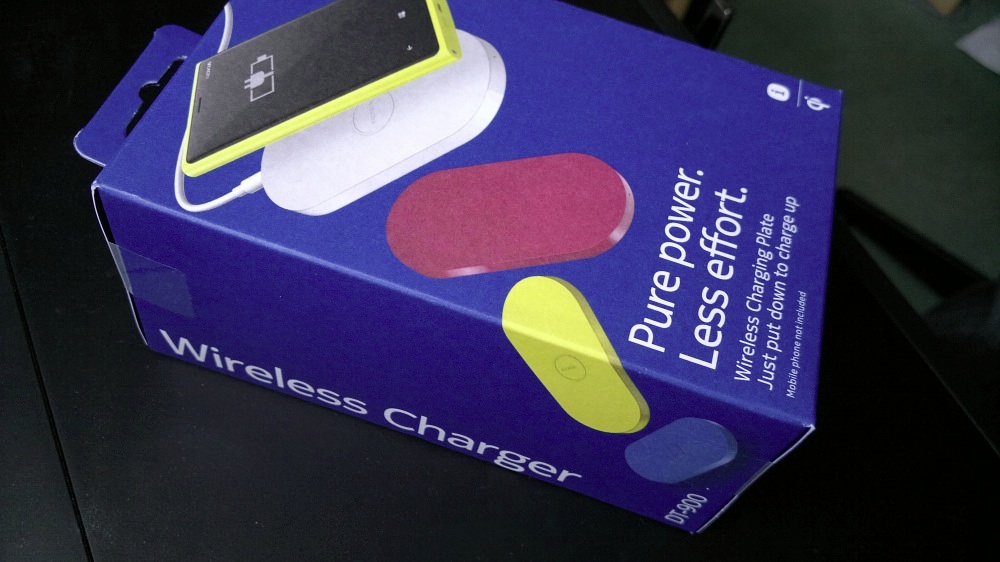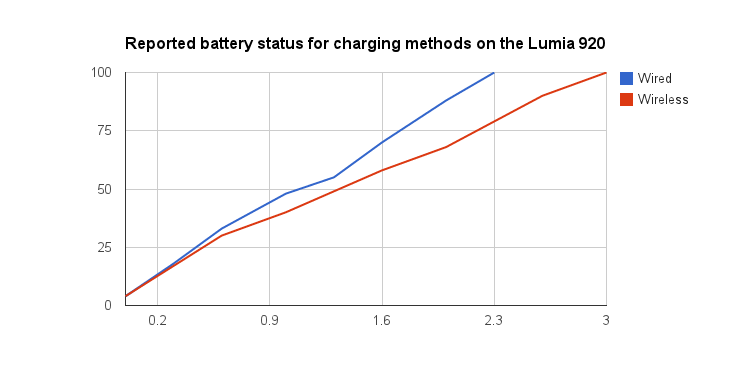Review: Nokia DT-900 Wireless Charger - living in the future
This, wireless charging, is supposed to be the future - but I approached this latest accessory with extreme caution. I understood the theory behind the Qi charging standard - electromagnetic induction, and so forth, but I was sceptical about the value proposition ('how hard is plugging in a cable, after all?') and I was even more sceptical about how much power could be transferred in this manner ('surely it's going to take five times as long to charge a phone?'). Well, I've been using the Nokia DT-900 Wireless Charger with the Lumia 920 for the last week and it has made me a believer. Turns out this really is the future.
Although the box here shows a variety of colours, the review accessory was black, but hey, at least it goes with everything in my house(!) The DT-900 retails for about £55 and for most use cases you're going to want at least two of these, so it's not a cheap solution - but then the future rarely is.

Before getting into why you might want two (or more) of these, here's what's in the box. There's a very chunky (though light) power adapter, with a plug-in cable of proprietary design - turns out this is because the DC that's needed is 12V, not Nokia's usual 5V (or so), so presumably Nokia wants to make sure people don't get confused and plug the wrong things in:

Although there's a fold-out manual for the DT-900, it's absolutely not needed - this is plug and play tech. The main charging plate is very solidly made out of plastic, with a hard rubber perimeter on the bottom to keep it firmly seated on a desk or table. The upper surface has a raised circle to show roughly where the charging coil is - it's raised to stop dust or dirt that will naturally collect on this usually exposed surface scratching or otherwise messing up your smartphone's pristine back.
This could actually be quite a short review - I placed the Lumia 920 on the DT-900 pad and... it started charging. The coils (in pad and in the back of the phone) can be misaligned by up to a couple of centimetres and charging will still happen, though efficiency will be hit if you're too far off centre. The pad is shaped in the rough aspect ratio (and size) of a typical phone, so it's actually very easy to get your phone laid comfortably and centred on the DT-900.
What really matters though is how efficient (or inefficient) the charging is. I took the Lumia 920 through a couple of complete charge cycles, replenishing the battery first with the 920's supplied mains charger and then the DT-900 Wireless Charger. Here are the results, shown graphically:

The wired charger took 2.3 hours to get to 100%, while the inductive pad took just 40 minutes longer to reach the same claimed battery state. Which really surprised me - I'd have guessed that charging times would be at least twice as long. A hit of an extra 15% or so on charging time is neither here nor there, especially when set against the potential extra convenience.
Which brings me to the use case. Convenience? Surely, if the wireless charger is plugged into the mains electricity anyway, then I might as well plug the phone in directly in the first place and save a lot of money?
Actually no. Think about how you use your smartphone. In my case, I'm surrounded by mains electricity for much of the day, yet my phone is only charged once, either at night or for a few hours when I first get into the office each morning. The rest of the time, my phone will be in my pocket or beside me on a table or desk, within reach of electricity but not plugged in because... "It's still got 60% left, it's not worth the hassle of plugging in the microUSB cable just for a bit of charging, I'll be off into another room or building in 20 minutes anyway."
Whether it's the hassle of constantly plugging (into a one-way-round-only, fiddly little socket) and unplugging a cable or worries over (literally) wearing out the socket, the fact is that most of us don't keep plugging our phones in ten times a day to keep giving them a top-up charge. Even though this is exactly what modern Lithium-Ion batteries love - it's how they're designed and it's the circumstances under which they'll give by far the longest life.
Being able to simply put your phone down on a charging pad by your desk or bed or coffee table and see it start charging completely changes one's behaviour here. Every time I'm at my desk I put the Lumia 920 down on the pad and more or less every time I pick it up I know that I'm starting again with the full 100% charge.

For a really mobile person who's out of reach of mains electricity all day, all this won't really apply, of course, but for 99.9% of us, imagine a future where you've got a pad in your office, another on the kitchen table (perhaps), one by the bedside, Qi charging pads built into Starbucks coffee tables, another inset into your car dash. All of a sudden, your phone is getting a dozen small top-ups throughout the day, with almost zero effort on your part and no mechanical wear and tear worries.
Which, hopefully, will mean no battery worries either - you'll simply always have enough charge in your ever more hungry smartphone. Of course, this utopia does assume that you'll own or come across enough of these charging pads and, right now, you'd have to be something of an early adopter, but take the financial hit and you're all of a sudden living in the future.
(My worry over charging time proved to be unfounded, though of course if you do need to charge an empty phone in a hurry, there's always the cable option too, for that extra 15% speed.)
The DT-900 is a somewhat pricey, but wonderfully effective accessory and I can highly recommend it. And apologies to your bank balance if you end up buying two or even three!
See also the official Nokia product page and MobileFun's other Lumia 920 Chargers. Thanks to them for the review sample.
Reviewed by Steve Litchfield at
